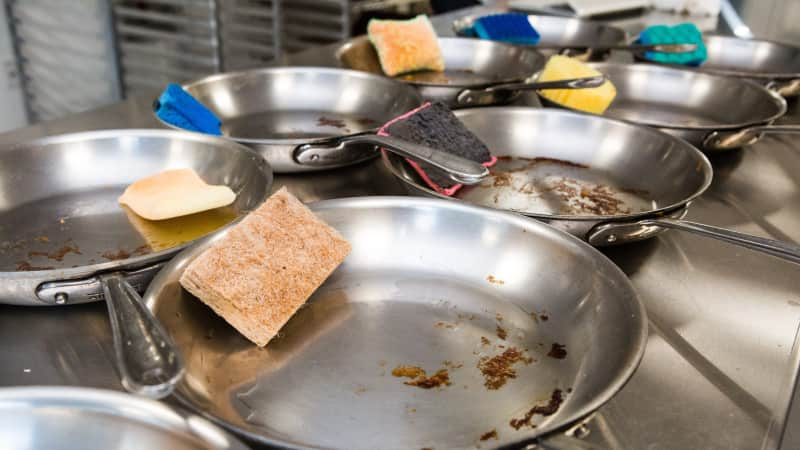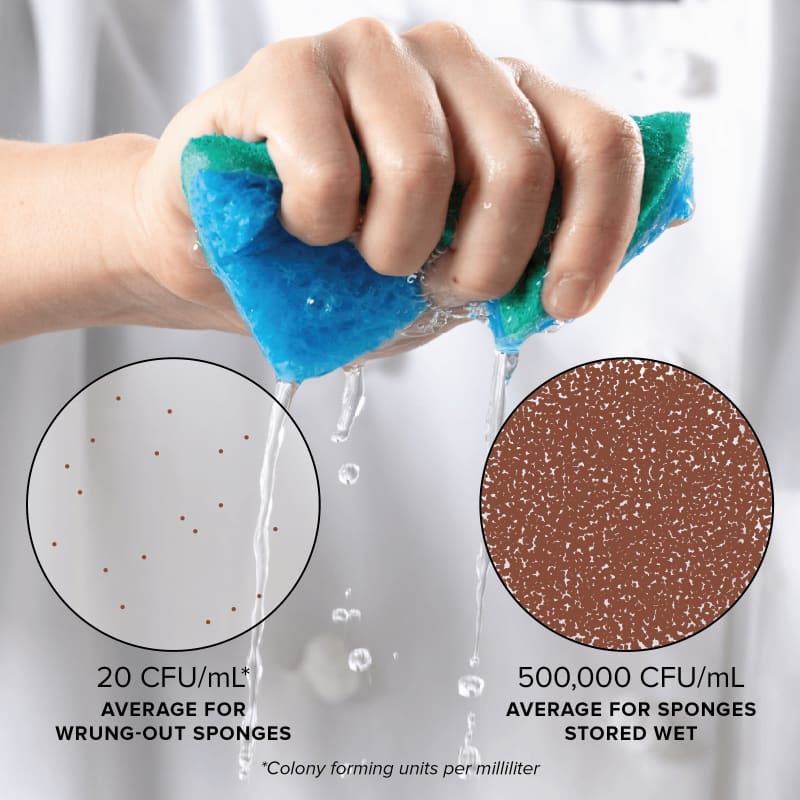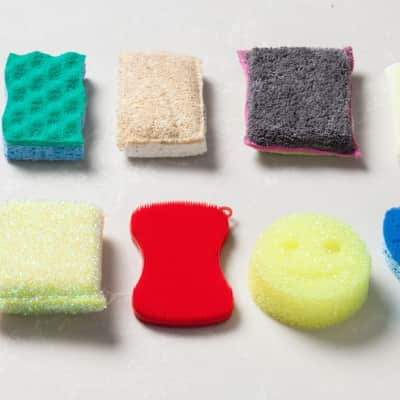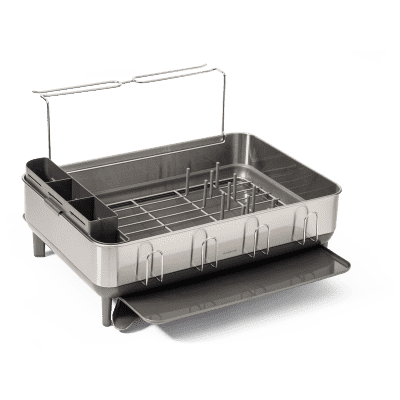When we do the dishes, we generally wring out the kitchen sponge after use. But we’ve all lived with roommates or family members who do the opposite. They wash their dishes and drop the sponge in the bottom of the sink, where it sits in a puddle and never fully dries out.
How to Clean a Kitchen Sponge
Published June 21, 2019.

Sponges have lots of little crevices and tend to be both warm and wet—an ideal environment for bacteria to flourish. So we were curious: Are those soggy sponges harboring more bacteria than sponges that we wrung out after use? We decided to find out.
Do Wet Kitchen Sponges Contain More Bacteria?
For two weeks, we used six identical sponges to clean up dishes, carefully measuring the amount of food, as well as the temperature of the water and the amount of soap we used. After each use, we squeezed the water out of three of the sponges and placed them in a dish rack so they could air-dry. We left the other three wet and set them in open plastic bowls, mimicking sponges that had simply been dropped and left in a damp place such as the bottom of the sink. After the two weeks, an independent lab measured the total bacterial count of each sponge in colony-forming units per milliliter (CFU/mL)—and the difference was staggering.

The sponges that had been left wet averaged more than 500,000 CFU/mL, while the wrung-out sponges came in at just 20 CFU/mL. The lab did not differentiate species of bacteria, so we don’t know if any of this bacteria was potentially harmful. But the conditions for growing good bacteria and bad bacteria are the same, and the results were clear: Wet sponges really do harbor more bacteria.
How to Sanitize a Kitchen Sponge
From now on, we’ll always wring out sponges and store them in a place where they can dry between uses. But even a clean kitchen sponge can still get grimy. Worse, it can stay damp on the inside even when it looks and feels dry on the outside.
To learn how to clean them, we turned to NSF International, a public health and safety organization that develops standards and certifications. Lisa Yakas, a microbiologist and home product certification expert at NSF International, proposed three methods:
METHOD 1: Dampen your sponge and microwave it for at least 2 minutes.
METHOD 2: Run your sponge through your dishwasher on a setting that reaches at least 155 degrees and has a heated dry cycle (sometimes called sani-rinse, sani-wash, or sanitation cycle), preferably every time you run your dishwasher.
METHOD 3: Submerge your sponge in a bleach solution (¾ cup of bleach for every gallon of water) for at least 5 minutes and then rinse it thoroughly.
After using any of these methods, allow the sponge to dry completely before using it again, ideally in a dish rack or a container that allows air to circulate around all surfaces of the sponge.
A good rule of thumb . . . is to replace your sponge every one to two weeks, cleaning it regularly in between uses, and storing it someplace where it can dry.
Does Sanitizing a Sponge Kill All the Bacteria?
The experts we spoke to insisted that regularly cleaning a sponge is essential. But it’s not going to remove every bit of bacteria or make your sponge last forever. Some studies show that these methods are effective, while others indicate that they remove no more than 60 percent of bacteria. At home, there’s just no way to know how much bacteria was on your sponge to begin with or how much has been killed. Neither at-home sanitization method will dramatically extend the life of your sponge. A good rule of thumb, according to Yakas, is to replace your sponge every one to two weeks, cleaning it regularly in between uses, and storing it someplace where it can dry.
The Best Kitchen Sponge for Home Kitchens
There’s one more way to guarantee that you get great results from your kitchen sponge: Buy a good one. We recently tested 10 different styles and were amazed by the differences. Some slipped and skid around a pan instead of scraping off cooked-on food. Some were too floppy or small to use comfortably. One became matted and grimy with leftover food particles, which was unpleasant to use and certainly didn’t feel clean. Our favorite, the O-Cedar Scrunge Multi-Use Scrubber Sponge, was a real improvement over the traditional blue sponge. Instead of a relatively smooth abrasive surface, its scrubber is slightly gritty and has bumps and valleys that really nudge off food residue with minimal effort. It’s also relatively inexpensive, about $10 for a six-pack, so you can replace your sponge regularly without breaking the bank.


